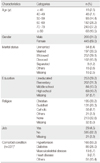Abstract
Purpose
The purpose of this study was to validate the Needs Assessment Tool for Case Management (NATCM) for use with Korean medical aid beneficiaries.
Methods
Psychometric testing was performed with a sample of 645 Korean medical aid beneficiaries, which included 41 beneficiaries who were selected using proportional sampling method, to examine intraclass correlation coefficients (ICC). Data were evaluated using item analyses, exploratory factor analysis (EFA), confirmatory factor analysis (CFA), Cronbach's alpha, and ICC.
Results
Through psychometric testing the final version of NATCM was found to consist of two subscales: 1) Appropriateness of Health Care Utilization (5 items) and 2) Self Care Ability (6 items). The two subscale model was validated by CFA (RMSEA=.08, GFI=.97, and CFI=.93). Internal consistency measured by Cronbach's alpha was .82, and subscale reliability ranged from .79 to .84. The ICC of the NATCM between case managers was .73 and between case managers and health care professionals. .82.
Conclusion
This study suggests that the final version of NATCM is a brief, reliable, and valid instrument to measure needs of Korean medical aid beneficiaries. Therefore, the NATCM can be effectively utilized as an important needs assessment as well as outcome evaluation tool for case management programs in Korea.
References
1. Ahn YH, Kim ES, Ko IS. The effects of tele-care case management services for medical aid beneficiaries. Journal of Korean Academy of Community Health Nursing. 2010. 21(3):351–361.
2. Ahn YH, Kim ES, Jang SJ, Ham OK, Kim SH, Kim SO, et al. Validation of needs assessment tool for case management among recipients in Korean medicaid. 2010. 05. Seoul: Ministry of Health and Welfare.
3. Anderson KL, Rokosky JS. Evaluation of a home health patient classification instrument. Western Journal of Nursing Research. 2001. 23(1):56–71. http://dx.doi.org/10.1177/01939450122044952.
4. Allen CE, Easley CE, Storfjell JI. Shaffer FA, editor. Cost management through caseload/workload analysis. Patients and purse strings: Patient classication and cost management. 1986. New York: National League for Nursing;331–346.
5. Byrne G, Brady AM, Griffith C, Macgregor C, Horan P, Begley C. The Community Client Need Classification System - a dependency system for community nurses. Journal of Nursing Management. 2006. 14(6):437–446. http://dx.doi.org/10.1111/j.1365-2934.2006.00672.x.
6. Center for Medicare and Medicaid Service. Case management regulation. 2009. Retrieved April 20, 2009. from http://www.cms.hhs.gov/.
7. Fleiss JL, Cohen J. The equivalence of weighted kappa and the intraclass correlation coefficient as measures of reliability. Educational and Psychological Measurements. 1973. 33:613–619. http://dx.doi.org/10.1177/001316447303300309.
8. Kim ES, Ahn YH, Ko IS, Lee KO, Ko JS. Planning and development of guide for medical aid case management services. 2008. Seoul: Ministry of Health, Welfare, and Family & Yonsei University College of Nursing, Institute of Nursing Policy.
9. Lee EO, Im NY, Park HA. Statistical analysis and nursing medical research. 1998. Seoul: Soomoonsa.
10. Lee HJ, Oh JJ, Choi JM. Comparison of case management between tele care regions and general care regions in Korean medicaid. Journal of Korean Academy of Nursing Administration. 2010. 16(4):381–388.
11. Ministry of Health and Welfare. Guide for medical aid program in 2009. 2009. Seoul: Author.
12. Ministry of Health, Welfare and Family. Guide for medical aid program in 2011. 2011. Seoul: Author.
13. Nunally CJ. Psychometric theory. 1978. 2nd ed. NY: McGraw-Hill.
14. Oh JJ. Outcome of a pilot project on case management service for medial and clients. Journal of Korean Academy of Public Health Nursing. 2010. 24(1):61–70.
15. Polit DF, Beck CT. Nursing research: Generating and assessing evidence for nursing practice. 2008. 8th ed. Philadelphia, PA: Lippincott Williams & Wilkins, a Wolters Kluwer Business.
16. Shin YS, Shin HW, Hwang DK. Case management and its the effectiveness in Korean Medicaid. 2007. Seoul: Korea Institute for Health and Social Affairs.
17. Shin YS. Direction to go for medical aid. Health and Welfare Policy Forum. 2010. 167:28–38.




 PDF
PDF ePub
ePub Citation
Citation Print
Print






 XML Download
XML Download